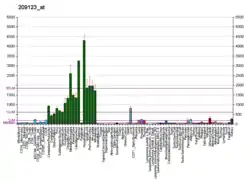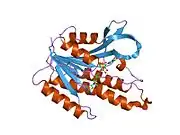QDPR
QDPR (quinoid dihydropteridine reductase) is a human gene that produces the enzyme quinoid dihydropteridine reductase. This enzyme is part of the pathway that recycles a substance called tetrahydrobiopterin, also known as BH4. Tetrahydrobiopterin works with an enzyme called phenylalanine hydroxylase to process a substance called phenylalanine. Phenylalanine is an amino acid (a building block of proteins) that is obtained through the diet; it is found in all proteins and in some artificial sweeteners. When tetrahydrobiopterin interacts with phenylalanine hydroxylase, tetrahydrobiopterin is altered and must be recycled to a usable form. The regeneration of this substance is critical for the proper processing of several other amino acids in the body. Tetrahydrobiopterin also helps produce certain chemicals in the brain called neurotransmitters, which transmit signals between nerve cells.
The QDPR gene is located on the short (p) arm of chromosome 4 at position 15.31, from base pair 17,164,291 to base pair 17,189,981.
In melanocytic cells QDPR gene expression may be regulated by MITF.[5]
Related conditions
Mutations in the QDPR gene are a common cause of tetrahydrobiopterin deficiency. More than 30 disorder-causing mutations in this gene have been identified, including aberrant splicing, amino acid substitutions, insertions, or premature terminations. These mutations completely, or almost completely, inactivate quinoid dihydropteridine reductase, which prevents the normal recycling of tetrahydrobiopterin. In the absence of usable tetrahydrobiopterin, the body cannot process phenylalanine correctly. As a result, phenylalanine from the diet builds up in the bloodstream and other tissues and can lead to brain damage. Neurotransmitters in the brain are also affected, resulting in delayed development, seizures, movement disorders, and other symptoms.
In addition, a reduction in the activity of quinoid dihydropteridine reductase may cause calcium to build up abnormally in certain parts of the brain, resulting in damage to nerve cells.
References
- GRCh38: Ensembl release 89: ENSG00000151552 - Ensembl, May 2017
- GRCm38: Ensembl release 89: ENSMUSG00000015806 - Ensembl, May 2017
- "Human PubMed Reference:". National Center for Biotechnology Information, U.S. National Library of Medicine.
- "Mouse PubMed Reference:". National Center for Biotechnology Information, U.S. National Library of Medicine.
- Hoek KS, Schlegel NC, Eichhoff OM, et al. (2008). "Novel MITF targets identified using a two-step DNA microarray strategy". Pigment Cell Melanoma Res. 21 (6): 665–76. doi:10.1111/j.1755-148X.2008.00505.x. PMID 19067971. S2CID 24698373.
Sources
- Romstad A, Kalkanoglu HS, Coskun T, Demirkol M, Tokatli A, Dursun A, Baykal T, Ozalp I, Guldberg P, Guttler F (2000). "Molecular analysis of 16 Turkish families with DHPR deficiency using denaturing gradient gel electrophoresis (DGGE)". Hum Genet. 107 (6): 546–53. doi:10.1007/s004390000407. PMID 11153907. S2CID 22889048.
- Shintaku H (2002). "Disorders of tetrahydrobiopterin metabolism and their treatment". Curr Drug Metab. 3 (2): 123–31. doi:10.2174/1389200024605145. PMID 12003346.
- Thony B, Auerbach G, Blau N (2000). "Tetrahydrobiopterin biosynthesis, regeneration and functions". Biochem J. 347 (1): 1–16. doi:10.1042/0264-6021:3470001. PMC 1220924. PMID 10727395.
Further reading
- Smooker PM, Cotton RG (1995). "Molecular basis of dihydropteridine reductase deficiency". Hum. Mutat. 5 (4): 279–84. doi:10.1002/humu.1380050402. PMID 7627180. S2CID 37519191.
- Kaufman S, Holtzman NA, Milstien S, et al. (1975). "Phenylketonuria due to a deficiency of dihydropteridine reductase". N. Engl. J. Med. 293 (16): 785–90. doi:10.1056/NEJM197510162931601. PMID 1160969.
- Howells DW, Forrest SM, Dahl HH, Cotton RG (1990). "Insertion of an extra codon for threonine is a cause of dihydropteridine reductase deficiency". Am. J. Hum. Genet. 47 (2): 279–85. PMC 1683733. PMID 2116088.
- Sumi S, Ishikawa T, Ito Y, et al. (1990). "Probable assignment of the dihydropteridine reductase gene to 4p15.31". Tohoku J. Exp. Med. 160 (1): 93–4. doi:10.1620/tjem.160.93. PMID 2330583.
- Dahl HH, Hutchison W, McAdam W, et al. (1987). "Human dihydropteridine reductase: characterisation of a cDNA clone and its use in analysis of patients with dihydropteridine reductase deficiency". Nucleic Acids Res. 15 (5): 1921–32. doi:10.1093/nar/15.5.1921. PMC 340608. PMID 3031582.
- Lockyer J, Cook RG, Milstien S, et al. (1987). "Structure and expression of human dihydropteridine reductase". Proc. Natl. Acad. Sci. U.S.A. 84 (10): 3329–33. Bibcode:1987PNAS...84.3329L. doi:10.1073/pnas.84.10.3329. PMC 304863. PMID 3033643.
- Altmann P, Al-Salihi F, Butter K, et al. (1987). "Serum aluminum levels and erythrocyte dihydropteridine reductase activity in patients on hemodialysis". N. Engl. J. Med. 317 (2): 80–4. doi:10.1056/NEJM198707093170204. PMID 3587329.
- Brown RM, Dahl HH (1987). "Localization of the human dihydropteridine reductase gene to band p15.3 of chromosome 4 by in situ hybridization". Genomics. 1 (1): 67–70. doi:10.1016/0888-7543(87)90106-6. PMID 3666748.
- Nakanishi N, Hasegawa H, Yamada S, Akino M (1986). "Purification and physicochemical properties of NADPH-specific dihydropteridine reductase from bovine and human livers". J. Biochem. 99 (3): 635–44. doi:10.1093/oxfordjournals.jbchem.a135522. PMID 3711039.
- Armarego WL, Ohnishi A, Taguchi H (1986). "New pteridine substrates for dihydropteridine reductase and horseradish peroxidase". Biochem. J. 234 (2): 335–42. doi:10.1042/bj2340335. PMC 1146570. PMID 3718470.
- Shen RS, Smith RV, Davis PJ, Abell CW (1984). "Inhibition of dihydropteridine reductase from human liver and rat striatal synaptosomes by apomorphine and its analogs". J. Biol. Chem. 259 (14): 8994–9000. PMID 6746636.
- Firgaira FA, Choo KH, Cotton RG, Danks DM (1982). "Molecular and immunological comparison of human dihydropteridine reductase in liver, cultured fibroblasts and continuous lymphoid cells". Biochem. J. 197 (1): 45–53. doi:10.1042/bj1970045. PMC 1163053. PMID 6797415.
- Maruyama K, Sugano S (1994). "Oligo-capping: a simple method to replace the cap structure of eukaryotic mRNAs with oligoribonucleotides". Gene. 138 (1–2): 171–4. doi:10.1016/0378-1119(94)90802-8. PMID 8125298.
- Katoh S, Sueoka T, Yamamoto Y, Takahashi SY (1994). "Phosphorylation by Ca2+/calmodulin-dependent protein kinase II and protein kinase C of sepiapterin reductase, the terminal enzyme in the biosynthetic pathway of tetrahydrobiopterin". FEBS Lett. 341 (2–3): 227–32. doi:10.1016/0014-5793(94)80462-1. PMID 8137944. S2CID 35666601.
- Su Y, Varughese KI, Xuong NH, et al. (1994). "The crystallographic structure of a human dihydropteridine reductase NADH binary complex expressed in Escherichia coli by a cDNA constructed from its rat homologue". J. Biol. Chem. 268 (36): 26836–41. doi:10.2210/pdb1hdr/pdb. PMID 8262916.
- Dianzani I, Howells DW, Ponzone A, et al. (1993). "Two new mutations in the dihydropteridine reductase gene in patients with tetrahydrobiopterin deficiency". J. Med. Genet. 30 (6): 465–9. doi:10.1136/jmg.30.6.465. PMC 1016417. PMID 8326489.
- Suzuki Y, Yoshitomo-Nakagawa K, Maruyama K, et al. (1997). "Construction and characterization of a full length-enriched and a 5'-end-enriched cDNA library". Gene. 200 (1–2): 149–56. doi:10.1016/S0378-1119(97)00411-3. PMID 9373149.
- Lin CM, Tan Y, Lee YM, et al. (1998). "Expression of human phenylalanine hydroxylase activity in T lymphocytes of classical phenylketonuria children by retroviral-mediated gene transfer". J. Inherit. Metab. Dis. 20 (6): 742–54. doi:10.1023/A:1005303331218. PMID 9427141. S2CID 22653168.
- Dianzani I, de Sanctis L, Smooker PM, et al. (1998). "Dihydropteridine reductase deficiency: physical structure of the QDPR gene, identification of two new mutations and genotype-phenotype correlations". Hum. Mutat. 12 (4): 267–73. doi:10.1002/(SICI)1098-1004(1998)12:4<267::AID-HUMU8>3.0.CO;2-C. PMID 9744478.








